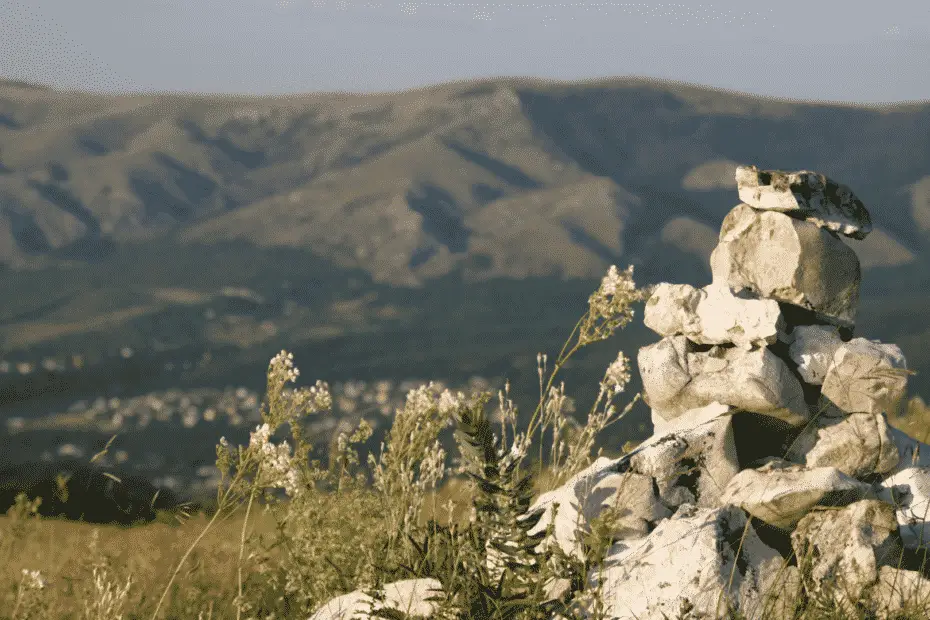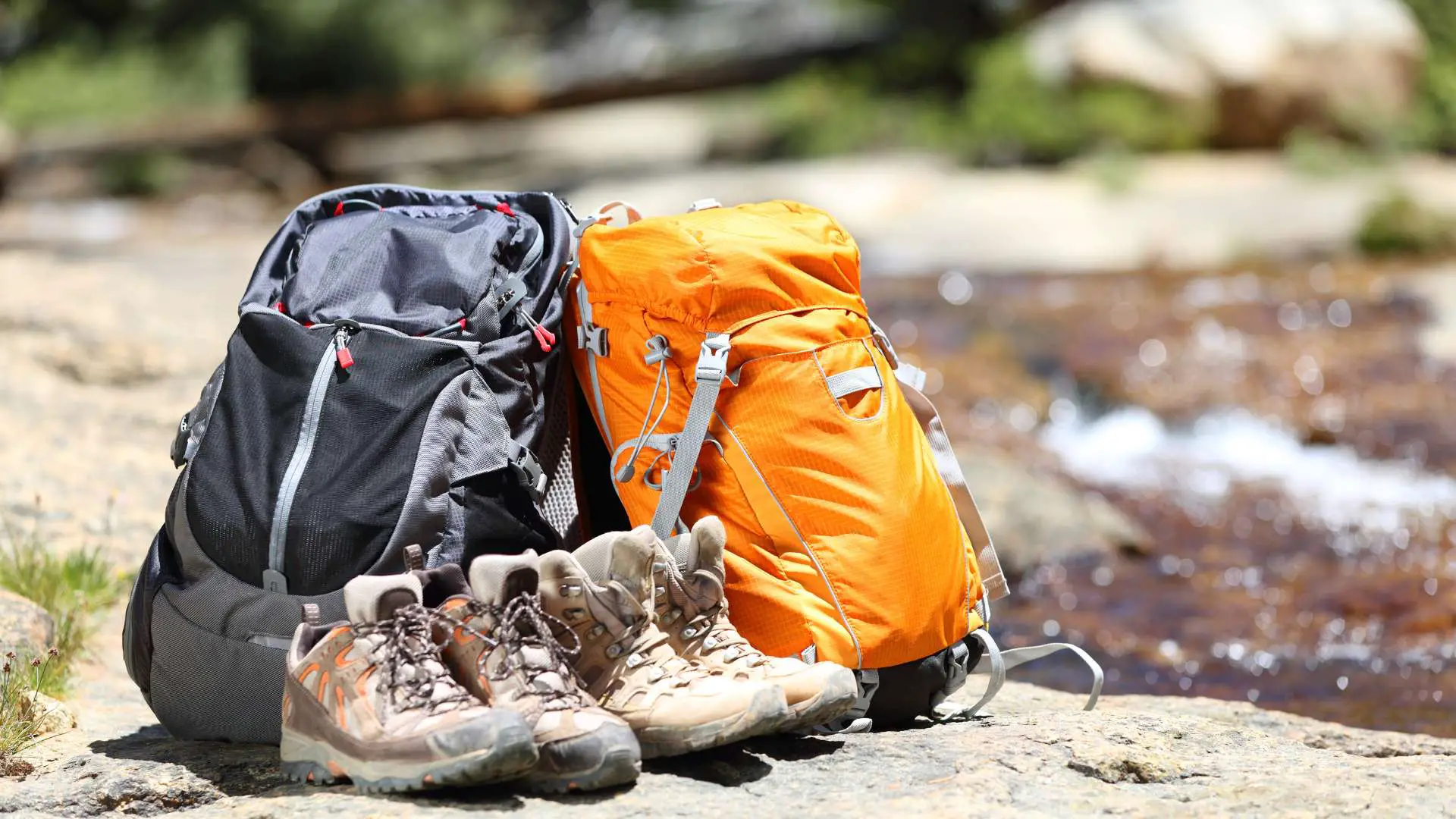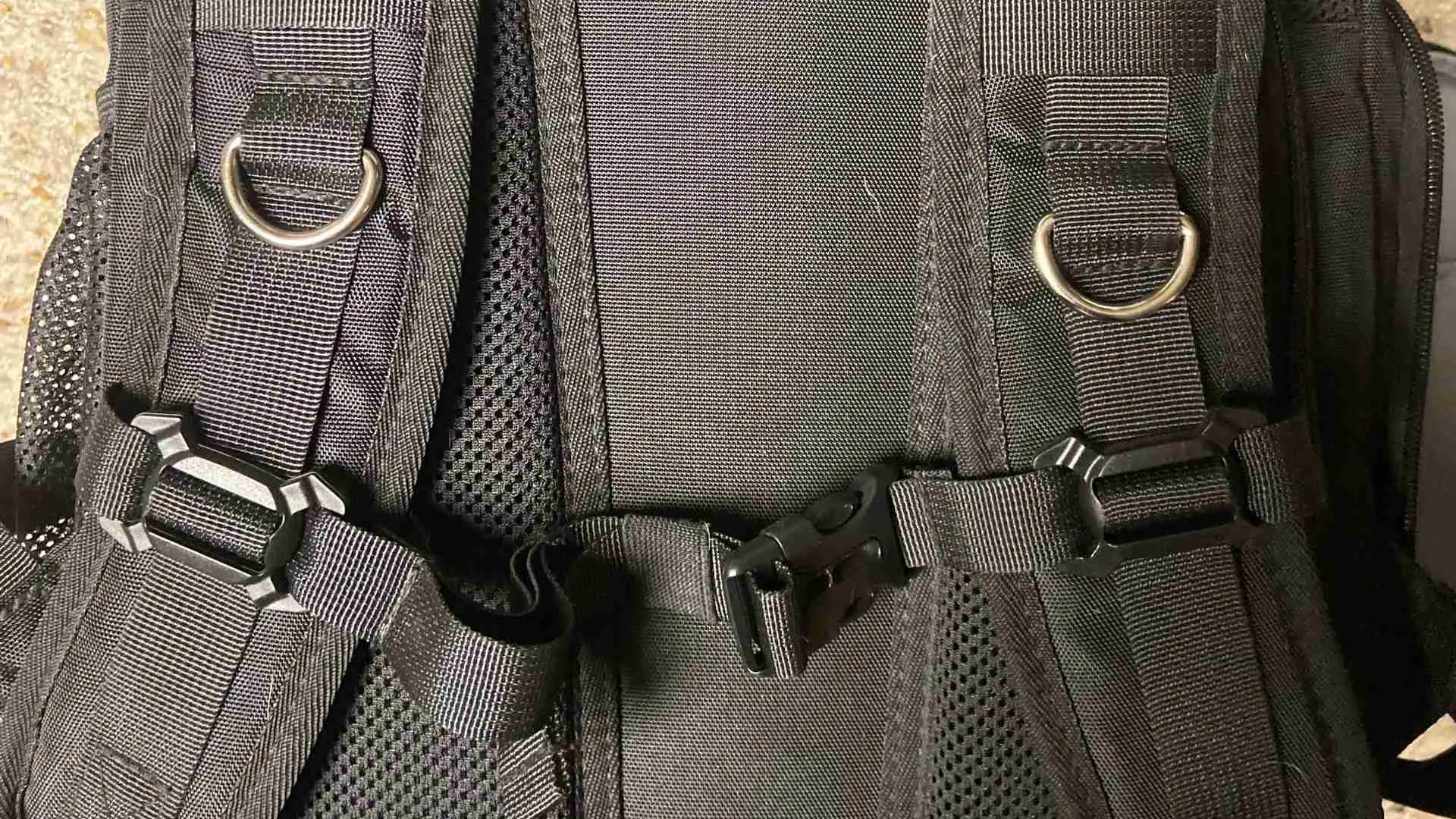Anybody that’s ever stumbled across a strange stack of rocks naturally wonders if there’s a meaning behind them. Is it some type of decorative art piece or is there another meaning behind it? Sometimes they’re made by random hikers, but they actually serve an important purpose in some National/State parks.
What Does A Stack Of Rocks Mean? A stack of rocks in national/state parks help keep hikers on the correct path. They’re maintained by park staff and trail helpers to guide visitors through hiking trails. Cairns tell hikers that they’re on the correct path when navigation becomes difficult on confusing trails.
Seeing a stack of rocks on the trail is a good thing. It signifies that you’re heading down the right path, but you can’t always trust rock cairns. Some hikers don’t understand the significance of cairns and build them for fun. So make sure you’re relying on multiple landmarks when navigating through unfamiliar trails.
In the rest of this post I’ll explain how to use cairns to navigate a trail and explain how to identify legitimate cairns. There are parks that don’t mind if you stack rocks, but make sure you check the park rules so you don’t send unsuspecting hikers off the trail.
Table Of Contents
What Is The Meaning Of Stacked Rocks aka Rock Cairns?
If you spend a lot of time hiking through national parks you will probably run into stacks of rocks. Most people don’t understand the importance of rock stacking, but they serve a very important purpose. Rock stacking doesn’t happen naturally so it’s an obvious sign that you’re on a man-made trail.
Rock balancing is a practice that’s been going on for 4,000 years. These rock stacks are called rock cairns, which comes from a Gaelic term that means “heap of stones”. We don’t know why people started stacking stones, but most experts think it was for either navigation or religious purposes.
When you go to a state or national park, you will most likely find stacked stones somewhere. Whether or not the stacked stones mean something depends on where you’re at. Some state and national parks continue the practice of building a rock cairn to help guide hikers down the trail.
Rock stacking is a cheap and easy way to tell hikers that they’re on the right path. Rock stacks are an immediate sign that you’re going the right way since rock balancing doesn’t happen naturally. It’s a subtle way of leaving behind a trail without having a major impact on the natural landscape.
Stacking rocks serve a similar purpose to trail blazes without violating leave no trace policies. Rock balancing tells hikers where to go and you can follow them from one rock cairn to the next.
There’s A Simple Problem With Using Rock Stacking To Mark Trails
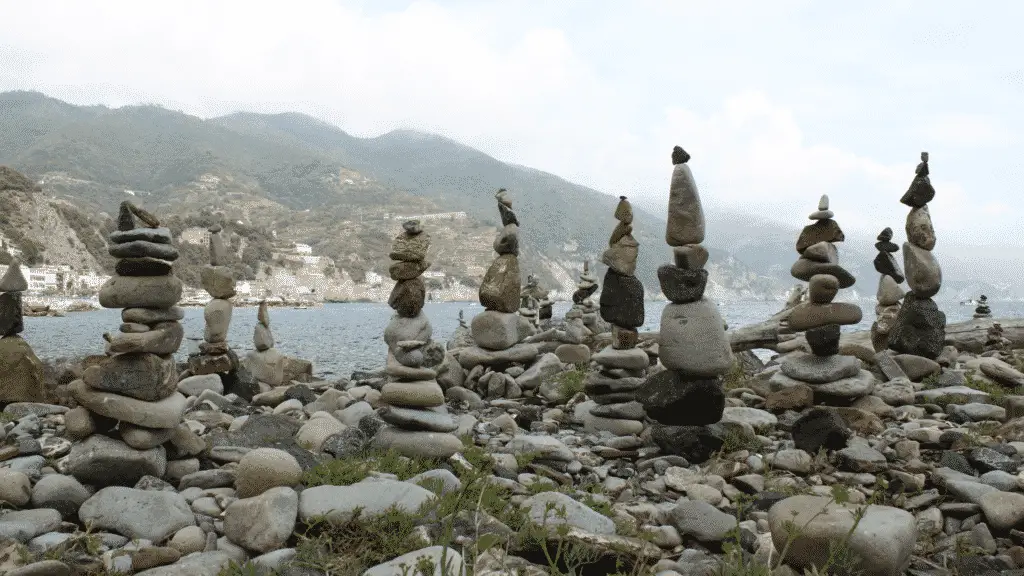
The practice of stacking stones as a form of trail navigation has an obvious flaw. Most hikers don’t know what stacking stones on a trail means. That leads to them deciding to stack stones without a real purpose or knocking over the rock stack without realizing how important they are.
Following trail cairns is like trying to navigate through a maze. You never know for sure if you’re going the right way. That’s why most places have started to use trail blazes instead. They’re semi-permanent, and less likely to be interfered with.
The picture above is a fairly obvious example of unofficial rock stacking. Whoever made those rock cairns is good at rock balancing, but they’re clearly not being used to mark a trail. Leave the rock stacking for the park management team so you don’t lead people down the wrong path. If you do decide to stack stones for artistic reasons, be responsible and knock over the pile when you leave.
The History Of Rock Balancing To Make Rock Cairns
Nobody knows where the practice of building rock cairns originated, but most people credit the Scots. So why did the Scots stack stones? There are massive 4,000 year old stone piles all over Scotland, but researchers can only guess the significance of massive piles of stacked stones.
Most experts think they were used to navigate across the hilly grasslands or for religious purposes to mark burial sites. Building a 10ft tall rock cairn doesn’t happen for no reason, so they had to serve an important purpose.
We still find stacks of rocks on trails across the globe. United States National Parks use cairns to help guide hikers down trails that are hard to navigate. Just be careful when following cairns, because inexperienced hikers build unauthorized cairns without realizing their true purpose.
Cairns serve a similar purpose to a trail blaze. They tell you the direction that you need to travel and inform you that you’re still on the trail. Learning how to read a stack of rocks can help you navigate through unfamiliar trails. Let’s go over the hidden meaning behind cairns and go over a few of the times where they’re commonly used.
- Cairns that are at the top of a summit signify the tallest part of a mountain. You may find a small opening with a summit register hidden inside.
- River cairns can serve an important message signifying the easiest route through a rough river. Look for rocks along the side of the cairn that point you in the direction of the easiest path. Be careful because rivers are a common place to find unofficial cairns.
- A desert landscape can be hard to navigate since everything looks the same. Desert cairns will tell you the correct trail route when there are multiple paths that you can take.
Difference Between Official Trail Cairns and Stacked Rocks
It can be hard to tell the difference between official navigational cairns and random stacks of rocks that hikers have built for fun. Whether or not it’s an official cairn depends on the park. Official cairns are almost always found in desert parks and rock faces where there won’t be a clearly traveled trail.
Cairns are commonly used in parks where it’s hard to establish a manmade trail. They’re commonly found in desert trails, rock faces, and alongside rivers. These are places where you won’t be able to follow a path carved by other hikers.
It’s hard to tell the difference between official cairns and stacked rocks that were built by random hikers. Use your best judgement and think about the trail you’re hiking. If the trail is known for having cairns then they’re safe to follow.
They can also be helpful in parks that don’t have official cairns. It tells you that other hikers have traveled down that path so you’re most likely going in the right direction. Sometimes you can rely on cairns and other times you can’t.
You should always have multiple navigational tools in your holster. Use cairns to point you in the right direction, but you should also use maps, compass, landmarks, and GPS if you’re in on an unfamiliar trail.
Desert Cairns
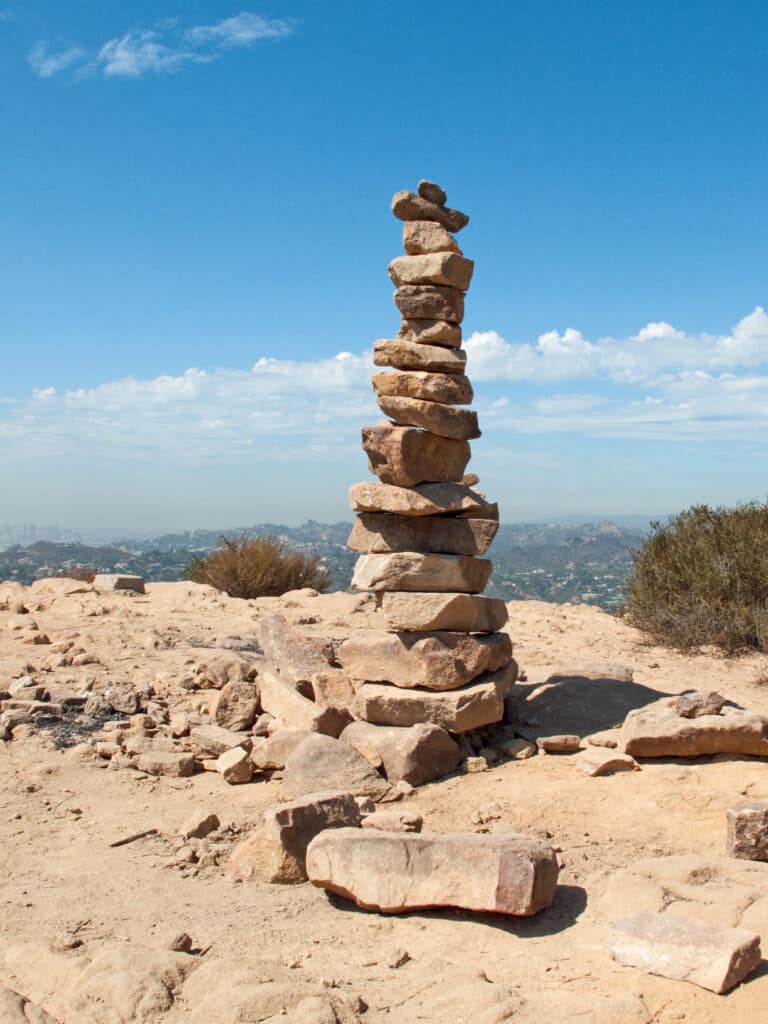
Trails become extremely challenging to follow in the desert. Even with frequent use, trails can be hard to spot. Plus it can be hard to distinguish landmarks when everything looks the same.
Hiking a dry wash dessert can feel like your strolling down an unmarked highway. You can follow the footprints for a while, but you’ll eventually drift into unmarked terrain. What are you going to do if you can’t find the route?
Start looking for cairns so you stay on the right path. Just follow the cairns and you won’t have to worry about getting lost. Desert cairns tend to be small and hastily built, but they’re a clear indication that you’re on the right path. You should also use cairns at confusing junctions to point you in the right direction.
Mountain and Summit Cairns
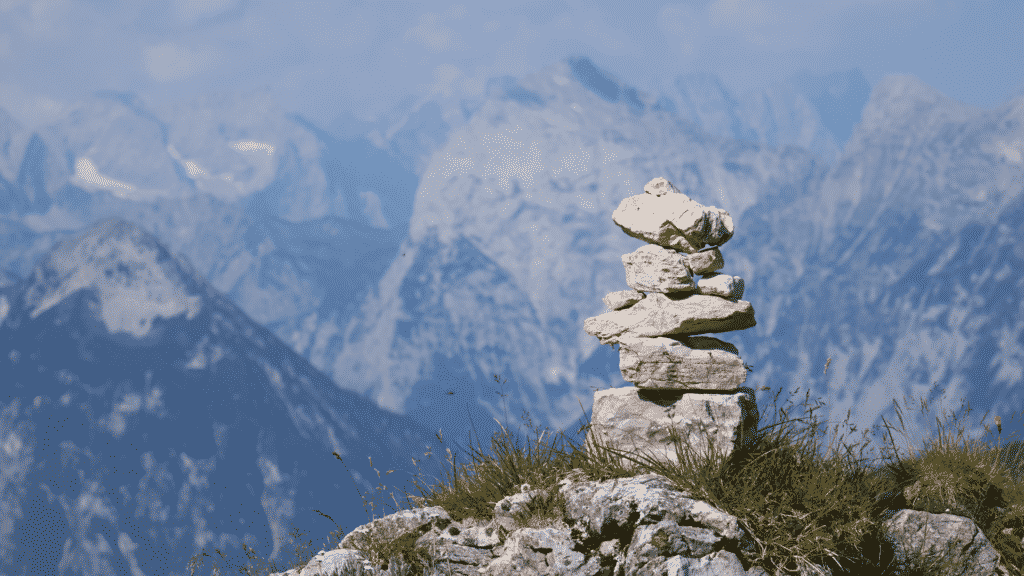
It can be hard to find your route on a mountain path. There won’t be a clear manmade path on rocky ground. You might see a patch of well traveled dirt, but you’ll have to follow cairns the rest of the way. Keep your eyes up and look for cairns to guide the way. Once you find a cairn you know that you’re on the right path.
Look at the top of the cairn and check to see if there’s a noticeable rock that juts out the side. This is usually an indicator that points you to the next cairn along the path. Trust your instincts and try to find the safest path up the mountain. If there’s no clear directional arrow use your best judgement to find the likeliest path.
Mountaineers and park staff have discovered the safest routes up a mountain path. So trust the cairn builders and follow the cairns, because that’s usually the easiest route. Cairns are usually built so they can be seen from one cairn to the next. So keep following the cairns until you make it up to the summit.
Reading rock cairns on a peak is self explanatory. It means you’ve reached the top of of the mountain, but there’s sometimes a hidden secret in a summit cairn. Look for a hollow opening in the cairn that holds a summit register in a PVC Tube, Ammo Box, or any other small waterproof container.
Use the summit register to sign in and alert other mountaineers if you experienced problems along the route. These tips will help future hikers find their way up the mountain.
River Cairns
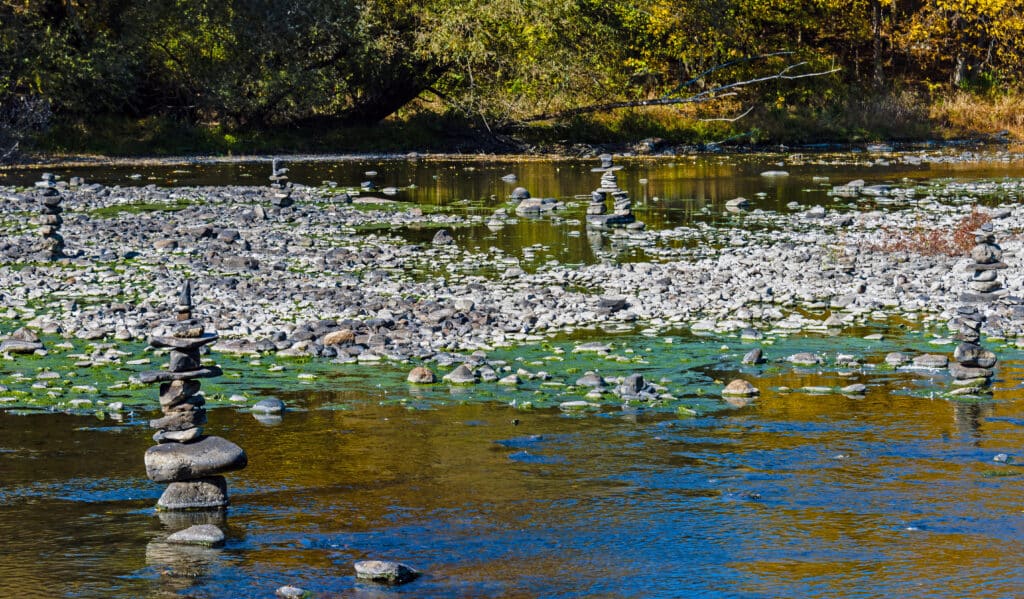
River cairns tend to be the least reliable. There are rocks everywhere so unofficial cairns are extremely common. Inspect the cairn to see if there’s a hidden meaning behind it. It’s especially important if you hear a load roar down the river. It could mean that this is the safest spot to cross the river.
Look across the river to see if you can spot another cairn. You may also see a cairn built on a mid stream boulder. Always use your best judgement when crossing a river, but this may mean that it’s the safest spot to cross the river.
These cairns can be helpful on a lazy winding river, but you need to be careful. Don’t trust the rocks and hope for the best. Scout ahead and try to find the safest spot to cross.
Forested Parks Rarely Use Navigational Cairns
Not every park uses cairns to designate established park trails. It’s easy to tell a designated trail in most of the United States. As hikers travel down a trail they leave their mark through the undergrowth making a clearly established path.
Just follow the path that was formed by thousands (maybe millions) of hikers that walked the trail before you. Trails that lead through forests and grasslands leave a clear impression on the soil so you shouldn’t have any problem following the trail.
State/National Parks rarely use cairns in wooded forest parks with dirt trails. Park staff typically uses trail blazes in forested trails since they’re a semi-permanent way to mark the route. You may still find cairns, but those were built by hikers with extra time on their hands. The park may have rules to prevent cairns so check before building your own.
Every Park Has Different Rules About Cairns
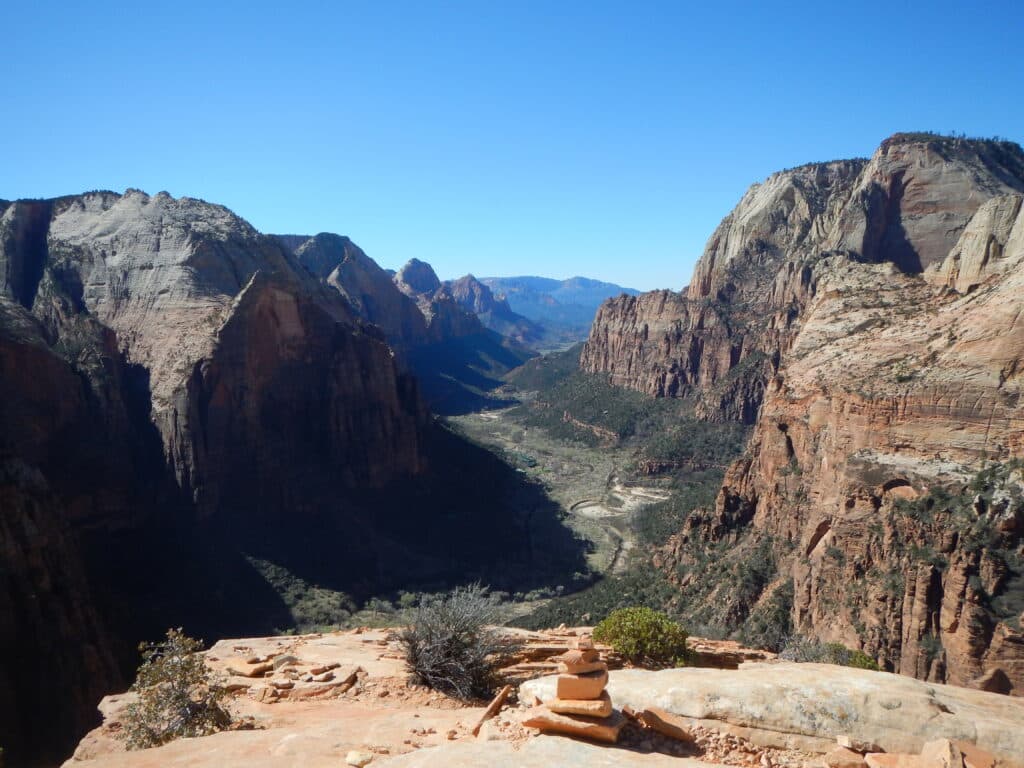
Not every park uses cairns to help guide hikers down their trails. It doesn’t take long to realize the problem with relying on this navigation system. Inexperienced hikers view stacked rocks as a form of artistic expression and decide to build unauthorized cairns.
This can lead to hikers following the wrong path and getting lost in unfamiliar terrain. Parks that don’t rely on cairns for trail navigation usually don’t care if you stack rocks, but make sure you check the park rules. You don’t want to endanger other hikers, because you thought it would be fun to stack rocks.
Here are a few rules that you need to follow when stumbling across a stack of rocks on the trail.
- Don’t Disassemble Cairns: Never take down a cairn that you find along the trail. It doesn’t matter whether or not you think the cairn is real or fake. Cairns are an important navigational tool on the trail and park staff can dismantle unofficial cairns.
- Do Not Build Unauthorized Cairns: Building unauthorized cairns can lead hikers down the wrong path. You don’t want to be the reason why a hiker gets lost and needs to be rescued.
- Do Not Add Rocks To Existing Cairns: Cairns are carefully designed by park staff and adding rocks to the pile can cause them to collapse. They may also tell you the direction to travel and moving/adding rocks can change the orientation of the cairn.
Every park has different ways to maintain trails and cairns, but they all follow the same rules. Never dismantle or disturb a cairn that you find along a trail. Don’t knock it down, add rocks, or do anything to the cairn. It doesn’t matter if you think the cairn is real or fake. Just leave it be so future hikers can safely navigate the trail.
It’s Illegal To Build Cairns In Some Parks
Rock cairns are a valuable navigational tool and building unofficial cairns endangers other hikers. It can be tempting to build your own stack of rocks, but it’s technically illegal in National Parks. Rangers consider stacked rocks as graffiti and you can be fined for building your own cairns.
Most rangers won’t enforce the fines, but you will get a stern lecture about the danger of building unauthorized cairns. They will force you to take them down and discourage visitors that are caught building them.
Adding to existing cairns is also a big problem. You can make it impossible to read the trail markers if they were constructed by park staff. The cairns were purposely crafted to point you in the right direction. You don’t want to send somebody off the trail and into a dangerous situation.
